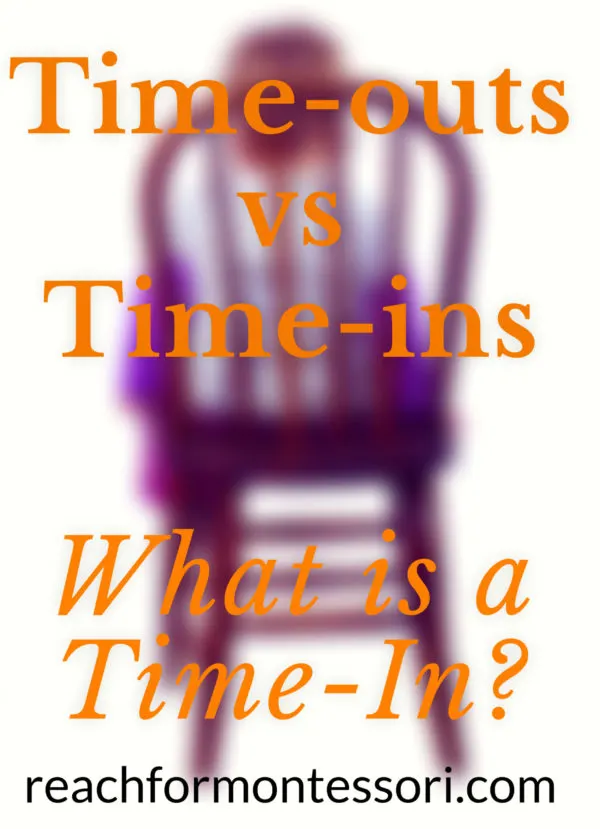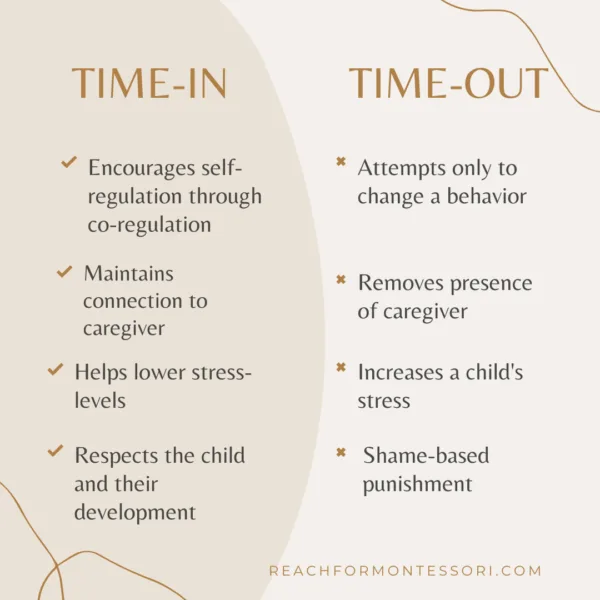If you are a parent, caregiver, or teacher, you have likely heard of time-outs. A time-out is a common method of behavior modification in children, generally considered a “gentle” alternative to spanking.
This is appealing to parents who are looking to avoid some of the traditional parenting practices many of us grew up with. Surface deep, they are a sensible alternative for parents looking to practice gentle parenting.
Are time-outs really gentle, though? Wouldn't a time-in be more gentle and more effective in helping children develop the emotional intelligence they need to be able to identify their emotions and express themselves appropriately?
Let's take a deeper look into the common practice of time-outs and answer the question, “What is a time-in?“

What are time-outs and why shouldn't we use them?
A time-out is often implemented when a child exhibits undesirable behavior, like throwing something or hitting, and is removed from the situation to be placed in isolation.
Many parents who use this method have a time-out corner or a “naughty chair” for this purpose.
The rule of thumb for time-outs is a child should get one minute of time-out for each year of age.
Time-outs are a form of “punishment by removal” and are sometimes recommended by pediatricians for behavior modification.
So, what is the problem with time-outs?
When a child acts out, such as in the case of throwing or hitting, they do so because they are feeling stressed out and they need direction identifying their feelings and expressing them in a productive way.
The child is removed from a loving, enjoyable environment and placed in isolation during a stressful moment. Instead of getting assistance with the situation, they receive punishment.
Parents tend to operate under the assumption that young children are in control of their behavior and that when acting out occurs it is purposeful and malicious.
Young children's brains don't work this way, though. It takes decades for our brains to fully develop, and in the meantime, impulse control lacks.
Simply stated, toddlers and very young children are not capable of consistent logical thought. Without logical thought, comes illogical behavior.
While time-outs may very well teach children that certain actions are not ok, the method of withdrawing attention as the consequence is problematic.
Time-outs are a form of fear and shame-based punishment. Time-outs serve only to punish, not provide children with the tools they need to express themselves in better ways for the long haul.
Not only do time-outs not contribute to the development of self-regulation and self-discipline, but they have also been proven to be ineffective in the long run.
There is a better alternative, though. Let's find out what a time-in is.

What is a time-in?
A technique commonly used in Montessori schools is called a “time-in”.
So, what is a time-in?
Time-ins are actually pretty similar to time-outs. They provide a break from the activity for the child to express themselves and calm down.
There is one major difference between a time-in vs a time-out, though: The presence and guidance of the caregiver.
Children who are acting out are responding to stress they cannot identify and/or communicate. Withdrawing our presence and comfort only increases their stress levels.
Having a caregiver present to co-regulate with the child, give language to their feelings, comfort, and guidance on alternative methods of expressing themselves is what makes time-ins a better “long game” for parents.

How do I implement a time-in?
Peace areas or designated quiet areas in your home/play space are great for time-ins, however, time-ins can be done anywhere, even when you are out and about.
Here is how to do a time-in:
- Remove the child from the stressful situation.
- Accompany them to a quieter area or a designated space in your home.
- Provide comfort until they are calm enough to communicate with you or for you to communicate with them, if the child is non-verbal.
- Give language to their emotions by using phrases such as, “I see you are frustrated that your block tower fell down.“
- Empathize and offer alternative ideas for handling the emotions. Example: “I sometimes feel frustrated, too. What is something we can do other than throwing blocks when we are frustrated? Let's try taking a deep breath and counting to 5 to see if that helps.“
- Practice the verbiage and new techniques with your child.
- Rejoin the activity, if your child wishes to continue.

Time-ins are a simple, gentle way of behavior modification that, over time, will improve your child's emotional intelligence. It is a long-term strategy, unlike a punishment. So, do not expect the immediate results of a fear-based punishment.
Using positive discipline in your parenting can make all the difference in the general stress level of your home.
For advice on how to side-step toddler tantrums, read here.
Do you use time-outs or time-ins with your child? What has your experience been with these methods?
Cheers and don't forget to subscribe!

Sankhamala
Thursday 11th of February 2021
Very helpful advice to parents follow positive parenting. Learned a lot.
Amanda
Monday 8th of February 2021
I’m saving this for when my babies are older. Good advice.
Angelika
Monday 8th of February 2021
This is really great! I never understand time outs myself (they never worked with my kids).
Nicole @ TheHelpMom
Monday 8th of February 2021
I believe in positive parenting as well. Often times with a screaming child, I remove them from the situation and set them down in a quiet area, I let her know that when she is done screaming and throwing a fit I will come back and talk with her to help fix the situation. She often just needs a break from her sibling and time to collect herself until she is ready to talk reasonably.
MyWorldTheirWay
Monday 8th of February 2021
Loved reading it. I have never been in favor of time outs. Instead I did most of the steps you mentioned above. Moved my kid away from the situation, asked them to breathe and calm down and giving language to their emotions.